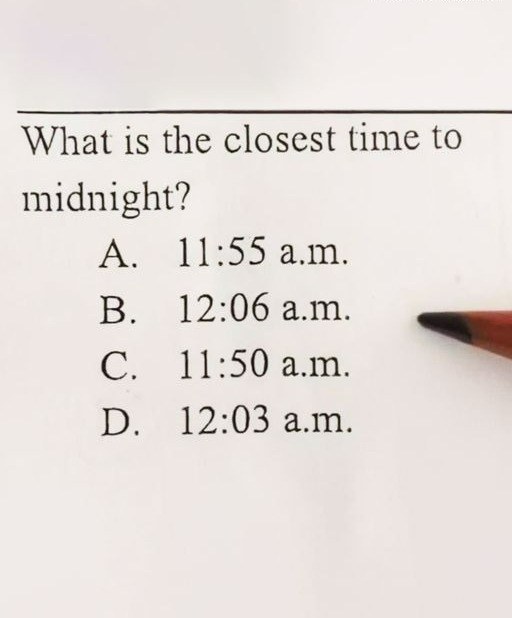Everyone loves a good brain teaser, and a recent math puzzle has been making waves across the internet. Originally designed for kids, this puzzle has captivated minds of all ages and sparked extensive debate online. It all started on Reddit, where a seemingly simple question turned into a global conundrum.

In June 2023, a Reddit user from Jamaica, known as @yawdmontweet, posed a puzzling question: “What is the closest time to midnight?” The options were:
- A. 11:55 a.m.
- B. 12:06 a.m.
- C. 11:50 a.m.
- D. 12:03 a.m.
What seemed like a straightforward question quickly snowballed into a viral debate, amassing over 1.4 million views and countless comments. The phrase “closest time to” left room for various interpretations, making this puzzle a hot topic for discussion.
The majority of Redditors leaned toward option D—12:03 a.m.—as the closest time to midnight. The reasoning was simple: 12:03 a.m. is just three minutes past midnight, making it the nearest time after the stroke of midnight.
However, not everyone was on board with this solution. Some argued that the wording “closest time to” versus “closest time until” might significantly alter the answer. For instance, option A (11:55 a.m.) could be considered closest to the upcoming midnight when viewed from the current time in the morning.
Others looked at the problem from a more creative angle. They pondered whether the term “midnight” itself influenced the choice. For example, since option A is the closest time before the next midnight, some argued it held a closer association with the term “midnight.”
Amidst the frenzy, some turned to artificial intelligence for a definitive answer. ChatGPT, an AI chatbot, straightforwardly declared that D. 12:03 a.m. was indeed the closest time to midnight. This response echoed the sentiment of many, adding to the puzzle’s intrigue.
The debate didn’t end with a single clear answer. One commenter highlighted the potential confusion such questions could create for children. With multiple interpretations possible, the question could either spark curiosity or cause frustration, potentially deterring young learners from engaging with math.
Option A: 11:55 a.m.
- Pros: Closest time to the next midnight in the context of the entire day.
- Cons: Not the closest time immediately following midnight.
Option B: 12:06 a.m.
- Pros: Only six minutes past midnight, a short duration.
- Cons: Slightly farther from midnight compared to 12:03 a.m.
Option C: 11:50 a.m.
- Pros: Before noon, indicating it’s closer to the upcoming midnight.
- Cons: Farther from midnight compared to the options after midnight.
Option D: 12:03 a.m.
- Pros: Three minutes past midnight, the closest time to the point of midnight.
- Cons: None, as it directly addresses the time right after midnight.
This math puzzle isn’t just about finding the closest time to midnight; it’s a reflection of how our brains approach problem-solving. It challenges us to think critically, consider different perspectives, and engage in lively discussions.
The viral math puzzle about the closest time to midnight has not only entertained but also educated us in critical thinking and interpretation. Whether you side with option D for its proximity after midnight or prefer the intriguing arguments for other choices, this puzzle is a testament to the fun and challenge inherent in problem-solving.
So, which option do you think is correct? Or perhaps, is there more than one valid answer depending on how you interpret the question? Dive into the debate and see where you stand in this global brain teaser!
This article aims to engage readers with a mix of detailed analysis, creative thinking, and interactive discussion, ensuring it remains both informative and captivating.





